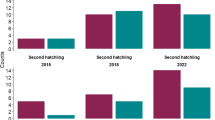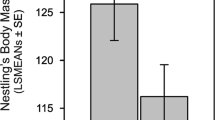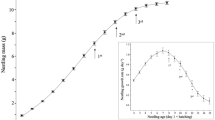Summary
First clutches of double-brooded eastern phoebes Sayornis phoebe were manipulated (up two eggs, down 2 eggs or no change) to test for intraseasonal reproductive tradeoffs and to test whether size of first brood influenced food delivery rates to nestlings and nestling quality in second broods.
Considering all nests from both broods, rate of feeding nestlings increased linearly with brood size but nestling mass per nest decreased with increasing brood size. High nestling weights in small broods may have resulted from parents delivering better quality food, but we did not test this.
Among treatment groups in first broods, nestlings from decreased broods weighed more than those in control or increased broods. Treatment did not influence the likelihood that second nests would be attempted after successful first nests nor did it alter the interval between nests. Nestlings of parents that renested weighed more than those of parents that did not, regardless of treatment, suggesting that post-fledging care may preclude renesting. Mass of individual females did not change between broods, regardless of brood size. Clutch sizes of second attempts were not affected by manipulations of first broods but increasing first broods reduced the number of nestlings parents were able to raise to day 11 in their second broods. However, manipulation of first broods did not affect mean nestling mass per nest of nestlings that survived to day 11.
In phoebes, parents of small first broods are able to raise nestlings in better condition. We predict that in harsh years, parents of small first broods would be more likely to renest. Parents of enlarged first broods sacrificed quality of offspring in second broods, which seems a reasonable strategy if nestlings from second broods have lower reproductive value.
Similar content being viewed by others
References
Bent AC (1942) Life histories of North American flycatchers, larks, swallows and their allies. US Natl Mus Bull 179
Coffey JW (1963) A nesting study of the eastern phoebe. Migrant 34: 41–49
Conrad KF, Robertson RJ (in prep) Cost of building or repairing nests: its influence on clutch size of eastern phoebes (Sayornis phoebe)
Curio E, Regelmann K, Zimmermann U (1984) The defence of first and second broods by great tit (Parus major) parents: a test of predictive sociobiology. Z Tierpsycol 66: 101–127
Faanes C (1980) Breeding biology of eastern phoebes in northern Wisconsin. Wilson Bull 92: 107–110
Gibb JA (1955) Feeding rates of great tits. Br Birds 48: 49–58
Grundel R (1987) Determinants of nestling feeding rates and parental investment in the mountain chickadee. Condor 89: 319–328
Hegner RE, Wingfield JC (1987) Effects of brood-size manipulations on parental investment, breeding success, and reproductive endrocrinology of house sparrows. Auk 104: 470–480
Henderson HN (1924) The phoebe. Bird Lore 26: 89–94
Hill SR, Gates JE (1988) Nesting ecology and microhabitat of the eastern phoebe in the central Appalachians. Am Midl Nat 120: 313–324
Johnston RF (1964) The breeding birds of Kansas. Univ Kans Mus Nat Hist Publ 12: 375–655
Klaas EE (1962) Nesting success and cowbird parasitism in the eastern phoebe in Kansas. Kans. Ornithol Soc Bull 13: 17–19
Klaas EE (1970) A population study of the eastern phoebe, Sayornis phoebe, and its social relationships with the brown-headed cowbird, Molothrus ater. Ph. D. Thesis, University of Kansas. 148 pp
Klomp H (1970) The determination of clutch-size in birds. A review. Ardea 58: 1–124
Lack D (1966) Population studies of birds. Clarendon Press, Oxford
Leffelaar D, Robertson RJ (1986) Equality of feeding roles and the maintenance of monogamy in tree swallows. Behav Ecol Sociobiol 18: 199–206
Lima SL (1987) Clutch size in birds: a predation perspective. Ecology 68: 1062–1070
Linden M (1988) Reproductive trade-off between first and second clutches in the great tit Parus major: an experimental study. Oikos 51: 285–290
Magrath RD (1991) Nestling weight and juvenile survival in the blackbird, Turdus merula. J Anim Ecol 60: 335–351
McGillivray WB (1983) Intraseasonal reproductive costs for the house sparrow (Passer domesticus). Auk 100: 25–32
Mueller HC, Mueller NS, Meyer KD (1982) Unusual nest attentiveness of an eastern phoebe. J Field Ornithol 53: 421–422
Murphy MT (1981) Growth and aging of nestling eastern kingbirds and eastern phoebes. J Field Ornithol 52: 309–316
Nur N (1984a) Feeding frequencies of nestling blue tits (Parus caeruleus): costs, benefits and a model of optimal feeding frequency. Oecologia 65: 125–137
Nur N (1984b) The consequences of brood size for breeding blue tits: II Nestling weight, offspring survival and optimal brood size. J Anim Ecol 53: 497–517
Nur N (1984c) The consequences of brood size for breeding blue tits: I. Adult survival, weight change and the cost of reproduction. J Anim Ecol 53: 497–517
Nur N (1987) Parents, nestlings and feeding frequency: a model of optimal parental investment and implications for avian reproductive strategies. In: Kamill A, Krebs JR, Pulliam HR (eds.) Foraging behaviour. Plenum Press, New York, pp 457–475
O'Connor RJ (1975) The influence of brood size upon metabolic rate and body temperature in nestling blue tits Parus caeruleus and house sparrows Passer domesticus. J Zool Lond 175: 391–403
Peck GK, James RD (1987) Breeding birds of Ontario, nidiology and distribution, vol. 2. Passerines. Royal Ontario Museum Life Sciences Miscellaneous Publication, Toronto
Perrins CM (1965) Population fluctuation and clutch-size in the great tit Parus major L. J Anim Ecol 34: 601–647
Reznick D (1985) Cost of reproduction: an evaluation of the empirical evidence. Oikos 44: 257–267
Rothstein SI (1986) A test of optimality: egg recognition in the eastern phoebe. Anim Behav 34: 1109–1119
Royama T (1966) Factors governing feeding rate, food requirement and brood size of great tits Parus major. Ibis 108: 313–347
Sasvari L (1986) Reproductive effort of widowed birds. J Anim Ecol 55: 553–564
Smith HG, Kallander H, Fontell K, Ljungstrom M (1988) Feeding frequency and parental division of labour in the double-brooded great tit Parus major. Effects of manipulating brood size. Behav Ecol Sociobiol 22: 447–453
Smith HG, Kallander H, Nilsson J-A (1987) Effect of experimentally altered brood size on frequency and timing of second clutches in the great tit. Auk 104: 700–706
Smith HG, Kallander H, Nilsson J-A (1989) The significance of clutch overlap in great tits Parus major. Ibis 131: 589–600
Smith JMN, Roff DA (1980) Temporal spacing of broods, brood size and parental care in song sparrows (Melospiza melodia). Can J Zool 58: 1007–1015
Smith WP (1942) Nesting habits of the eastern phoebe. Auk 59: 410–417
Stoner D (1939) Temperature, growth and other studies on the eastern phoebe. N Y State Mus Circ 22: 1–42
Tinbergen JM (1987) Costs of reproduction in the great tit: intraseasonal costs associated with brood size. Ardea 75: 111–112
Tinbergen JM, van Balen JH (1989) Food and multiple breeding. Acta. Congr Inter Ornithol 19: 379–391
Tuomi J, Hakala T, Haukioja E (1983) Alternative concepts of reproductive effort, costs of reproduction, and selection in life history evolution. Am Zool 23: 25–34
Via JW (1979) Foraging tactics of flycatchers in southwestern Virginia. In: Dickson JG, Connor RR, Fleet RR, Jackson JA, Kroll JC (eds) The Role of insectivorous birds in forest ecosystems. Academic Press, New York, pp 191–202
Weeks HP (1978) Clutch size variation in the eastern phoebe in southern Indiana. Auk 95: 656–666
Weeks HP (1979) Nesting ecology of the eastern phoebe in southern Indiana. Wilson Bull 91: 141–154
Wilkinson L (1990) Systat. The system for statistics. Systat Inc., Evanston, Illinois, USA
Williams GC (1966) Natural selection, the costs of reproduction and a refinement of Lack's principle. Am Nat 100: 687–690
Author information
Authors and Affiliations
Rights and permissions
About this article
Cite this article
Conrad, K.F., Robertson, R.J. Intraseasonal effects of clutch manipulation on parental provisioning and residual reproductive value of eastern phoebes (Sayornis phoebe). Oecologia 89, 356–364 (1992). https://doi.org/10.1007/BF00317413
Received:
Accepted:
Issue Date:
DOI: https://doi.org/10.1007/BF00317413




